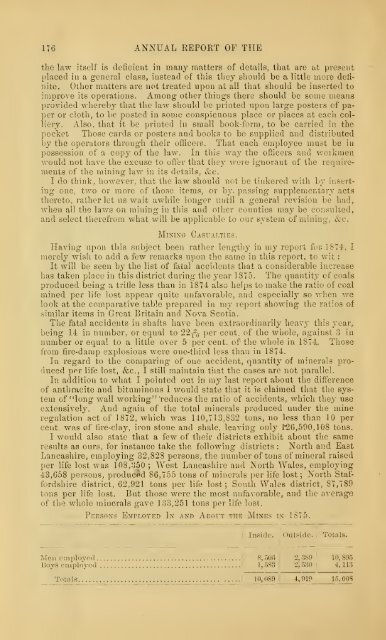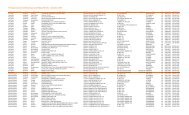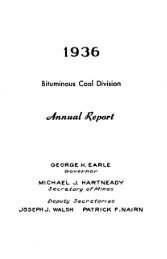Reports of the Inspectors of Mines of the anthracite coal regions of ...
Reports of the Inspectors of Mines of the anthracite coal regions of ...
Reports of the Inspectors of Mines of the anthracite coal regions of ...
You also want an ePaper? Increase the reach of your titles
YUMPU automatically turns print PDFs into web optimized ePapers that Google loves.
176 ANNUAL REPORT OF THE<br />
<strong>the</strong> law itself is deficient in many matters <strong>of</strong> details, that are at present<br />
placed in a general class, instead <strong>of</strong> this <strong>the</strong>y should be a little more defi-<br />
nite. O<strong>the</strong>r matters are not treated upon at all that should be inserted to<br />
improve its operations. Among o<strong>the</strong>r things <strong>the</strong>re should be some means<br />
provided whereby that <strong>the</strong> law should be printed upon large posters <strong>of</strong> paper<br />
or cloth, to be posted in some conspicuous place or places at each colliery.<br />
Also, that it be printed in small book-form, to be carried in <strong>the</strong><br />
pocket Those cards or posters and books to be supplied and distributed<br />
by <strong>the</strong> operators through <strong>the</strong>ir <strong>of</strong>ficers. That each employee must be in<br />
possession <strong>of</strong> a copy <strong>of</strong> <strong>the</strong> law. In this way <strong>the</strong> <strong>of</strong>ficers and workmen<br />
would not have <strong>the</strong> excuse to <strong>of</strong>fer that <strong>the</strong>y were ignorant <strong>of</strong> <strong>the</strong> requirements<br />
<strong>of</strong> <strong>the</strong> raining law in its details, &c.<br />
I do think, however, that <strong>the</strong> law should not be tinkered with by inserting<br />
one, two or more <strong>of</strong> those items, or by. passing supplementary acts<br />
<strong>the</strong>reto, ra<strong>the</strong>r let us wait awhile longer until a general revision be had,<br />
when all <strong>the</strong> laws on niining in this and o<strong>the</strong>r counties may be consulted,<br />
and select <strong>the</strong>refrom what v^ill be applicable to our system <strong>of</strong> mining, Sec.<br />
Mining Casualties.<br />
Having upon this subject been ra<strong>the</strong>r lengthy in my report fur. 1ST4, I<br />
merely wish to add a few remarks upon <strong>the</strong> same in this report, to wit :<br />
It will be seen by <strong>the</strong> list <strong>of</strong> fatal accidents that a considerable increase<br />
has taken place in this district during <strong>the</strong> year 1875. The quantity <strong>of</strong> <strong>coal</strong>s<br />
produced being a trifle less than in 1874 also helps to make <strong>the</strong> ratio <strong>of</strong> <strong>coal</strong><br />
mined per life lost appear quite unfavorable, and especially so when we<br />
look at <strong>the</strong> comparative table prepared in my report showing <strong>the</strong> ratios <strong>of</strong><br />
similar items in Groat Britain and Nova Scotia.<br />
The fatal accidents in shafts have been extraordinarily heavy this year,<br />
being 14 in number, or equal to 22383 per cent, <strong>of</strong> <strong>the</strong> whole, against 3 in<br />
number or equal to a little over 5 per cent, <strong>of</strong> <strong>the</strong> whole in 1874. Those<br />
from fire-damp explosions were one-third less than in 1874.<br />
In regard to <strong>the</strong> comparing <strong>of</strong> one accident, quantity <strong>of</strong> minerals produced<br />
pPT life lost, &c., I still maintain that <strong>the</strong> cases are not parallel.<br />
In addition to what I pointed out in ray last report about <strong>the</strong> difference<br />
<strong>of</strong> <strong>anthracite</strong> and bituminous I would state that it is claimed that <strong>the</strong> system<br />
<strong>of</strong> "long wall woi'liing'^'i-edaces <strong>the</strong> ratio <strong>of</strong> accidents, which <strong>the</strong>y use<br />
extensively. And again <strong>of</strong> <strong>the</strong> total minerals produced under <strong>the</strong> mine<br />
regulation act <strong>of</strong> 1872, which was 140,713,832 tons, no less than 10 per<br />
cent, was <strong>of</strong> fire-clay, iron stone and shale, leaving only 1*26,590,108 tons.<br />
I would also state that a few <strong>of</strong> <strong>the</strong>ir districts exhibit about <strong>the</strong> same<br />
results as ours, for instance take <strong>the</strong> following districts : North and East<br />
Lancashire, employing 32,828 persons, <strong>the</strong> number <strong>of</strong> tons <strong>of</strong> mineral raised<br />
per life lost was 108,350 ; West Lancashire and North Wales, employing<br />
43,658 persons, producefd 86,755 tons <strong>of</strong> minerals ])er life lost ; North Staffordshire<br />
district, 62,921 tons per life lost; South Wales district, 87,789<br />
tons per life lost. But those were <strong>the</strong> most unfavorable, and <strong>the</strong> average<br />
<strong>of</strong> tlie whole minerals gave 133,251 tons per life lost.<br />
Persons EiMployed In and About <strong>the</strong> <strong>Mines</strong> in 1875.<br />
I Inside.<br />
Outside, i<br />
Totals.<br />
'<br />
Men emploved 8, 500 2, 389 10, 895<br />
Boys employed 1,583 2,530} 4,113<br />
Totals i<br />
10,089:<br />
4,919, 15,008




![1945 Anthracite Annual Report Districts 19 - 25 [Adobe pdf - 9148Kb]](https://img.yumpu.com/50308099/1/190x119/1945-anthracite-annual-report-districts-19-25-adobe-pdf-9148kb.jpg?quality=85)


![1937 Anthracite Annual Report Districts 1 - 11 [Adobe pdf - 9394Kb]](https://img.yumpu.com/43539962/1/190x119/1937-anthracite-annual-report-districts-1-11-adobe-pdf-9394kb.jpg?quality=85)







![1931 Anthracite Annual Report Districts 1 - 11 [Adobe pdf - 8007Kb]](https://img.yumpu.com/39427789/1/190x119/1931-anthracite-annual-report-districts-1-11-adobe-pdf-8007kb.jpg?quality=85)

